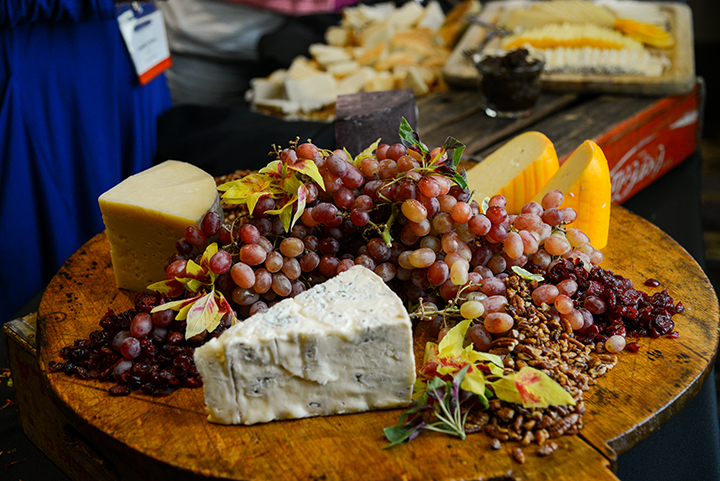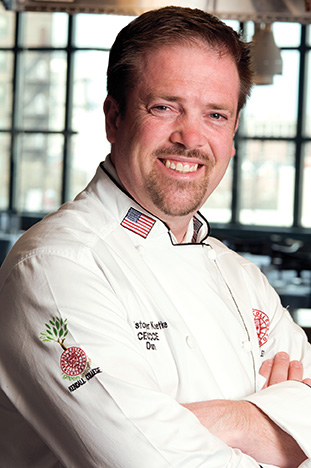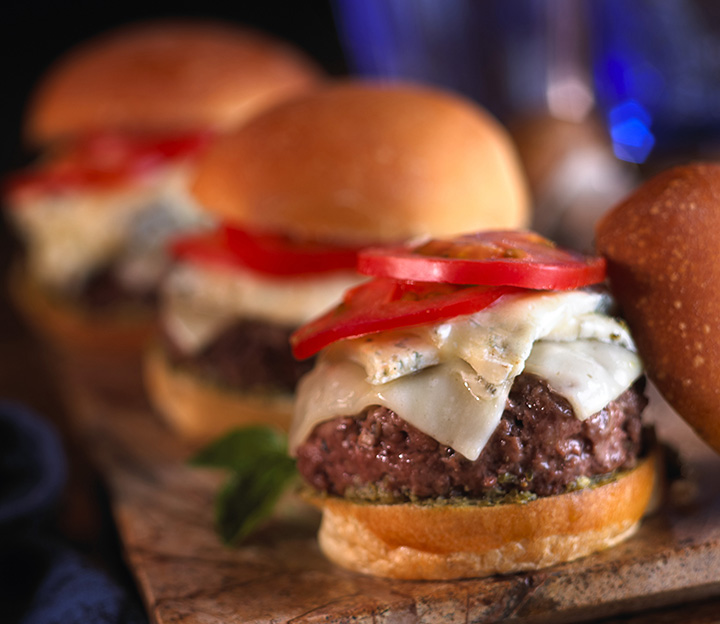Revolution is a strong word. It denotes not just change, but something big, impactful, and truly different. In the business world, revolution is a term that tends to be overused and, frankly, misused as a label and descriptor for a host of concepts, ideas, and events that don’t really meet the criteria. What has happened to cheese in this country in the last 10 to 15 years, though, is nothing short of a true revolution.

A catered afternoon break from Duvall Events offered a variety of cheeses from pungent to comforting, along with appropriate accoutrements during a catering summit in Charleston, S.C.; Photo by Alex Quijano
Twenty years ago, I was a chef for one of Chicago’s premier French fine-dining establishments, which was known for its cheese cart. As chef, I went to great lengths to procure fine, high-quality, flavorful cheeses through a network of small wholesalers. The moment a new shipment arrived, they called. Our customers tended to be well travelled and understood the beauty of full-flavored and even stinky cheeses. They were intrigued by cheese covered in mold or with a pungent rust-colored exterior. They appreciated the selection of cheeses made from cow, goat, and/or a mix of sheep milk.
I would not characterize what we did back then on our cheese cart as a revolution, as it only impacted a tiny percentage of the population. What has happened since then among the general public, however, is a revolution. America has learned that cheese is meant to have flavor. America has learned that there are fascinating cheeses beyond processed or mildly flavored. America has learned that a multi-year aged cheddar is infinitely more flavorful, intense, umami-rich, and interesting than a younger one—and, that it is worth a higher price tag.
The societal change
Grocery stores are a direct reflection of the taste profiles of the wider population. A quick check of stores like Whole Foods or other local stores within this type of market segment reveals a sizeable store footprint dedicated to a growing selection of cheeses. Even outside of these high-end specialty stores, more mainstream grocery stores have also increased their cheese offerings and the prices that accompany them. Americans bought 664 million pounds of specialty cheese at retail establishments in 2015, which is quite an increase from 2010 where sales were 582 million pounds. Currently, the state of Wisconsin produces 46 percent of the nation’s specialty cheeses. Retail sales of specialty cheese reached $4.7 billion last year. The point is that America is interested in higher-quality cheeses that offer deliciously new dining experiences. This is the revolution. It is a societal change and it is not going away.
America’s growing appreciation for cheeses with unique flavor profiles provides foodservice across the industry a compelling opportunity to diversify their menu offerings. Unusual cheeses, cheeses with stories, big cheeses, and bold cheeses all add up to flavor and sales, with endless possibilities. For instance:
• Sandwiches are an ideal home for flavor-forward cheeses, as bread and cheese is a classic. Brie and Camembert, for example, contribute a rich texture and complex flavor, especially when they are well aged. A flavored mascarpone spread on bread can tastefully replace ingredients such as butter or mayonnaise. Consider combining several different cheeses on one sandwich for increased complexity.
• Boxed lunches can benefit from some of the sandwich ideas mentioned above. At the same time, why not mix up the traditional boxed lunch and ditch the sandwich altogether. For instance, providing an assortment of cheeses, some crusty bread, and fresh fruit feels more like Paris than just a boxed lunch.
• Panini, grilled cheese, other hot sandwiches, and even pizza are also great platforms to experiment with new and different cheeses. Heating cheese also expands its aromatic flavor profile—which, to cheese lovers, is like fine perfume. Putting cheeses like Taleggio or Pleasant Ridge Reserve (an alpine-style cheese) on panini will take it to another flavor dimension. For pizza, try adding smaller amounts of pungent cheeses to grated mozzarella. For instance, adding Gorgonzola to a pizza allows you to upsell it as something unique. At the same time, you only need a small amount to achieve the desired flavor boost.
• Creating a differentiated hamburger or slider is yet another way to leverage unique cheeses in boosting both sales and check averages. What happens when the cheese of the cheeseburger becomes the focus? Answer: unique flavors that will leave your guests talking about it the next day.
As we teach our students at Kendall College, learning the foodservice industry is more than learning how to cook. It is also about learning the business of our business, and ultimately how to make profit. The cheese revolution is good for business. Certainly, high quality and individualized cheeses cost more. At the same time, they allow for creative recipe development and interesting flavor profiles. Often, smaller quantities of these cheeses are needed to achieve a desired outcome. Ultimately, great cheeses appeal to a growing market segment of people who want memorable food experiences. And, these are the same customers who are willing to pay for quality.
 Chef Christopher Koetke is the host of “Let’s Dish” on the Live Well network and vice president of the School of Culinary Arts at Kendall College in Chicago, IL.
Chef Christopher Koetke is the host of “Let’s Dish” on the Live Well network and vice president of the School of Culinary Arts at Kendall College in Chicago, IL.
 A crisp kale cup is filled with whipped goat cheese and then topped with preserved lemon and red quinoa. Photo courtesy of Blue Plate and ©Artisan Events
A crisp kale cup is filled with whipped goat cheese and then topped with preserved lemon and red quinoa. Photo courtesy of Blue Plate and ©Artisan Events

Rhubarb, bacon and onion compote with Wisconsin Pleasant Ridge Reserve on toasted whole-grain bread. Recipe below. Photo courtesy of WI Milk Marketing Board
Rhubarb, Bacon and Onion Compote
with Wisconsin Pleasant Ridge Reserve Cheese on Toasted Whole Grain Bread
Servings: 20
Ingredients
1/4 lb. sliced bacon, diced
1 sweet onion, thinly sliced
2 stalks red rhubarb, diced
3 tablespoons apple cider vinegar
½ cup light brown sugar
Pinch of ground cinnamon
Pinch of ground cardamom
1 teaspoon chopped fresh chives
1 teaspoon chopped fresh parsley
20 slices whole grain bread
20 oz. Wisconsin Pleasant Ridge Reserve cheese or Gruyere cheese
Cooking Directions:
Compote:
Heat large skillet over medium-high heat. Add bacon; cook until brown and crisp. Add onion, stirring to pick up browned bits on bottom of pan. Reduce heat to medium-low; cook 8 to 10 minutes, until soft and slightly caramelized. Stir in rhubarb. Add vinegar, brown sugar, cinnamon and cardamom. Cook 5 to 8 minutes or until rhubarb is soft. If rhubarb is very tart, add 1 to 2 additional tablespoons brown sugar. Spoon compote into container and refrigerate until cool. Stir in chives and parsley.
Final Preparation:
For each serving, toast a slice of whole grain bread. Remove crusts and cut into 2 triangles. Cut Pleasant Ridge Reserve cheese into 1 oz. wedges; place one wedge on each triangle. Top each cheese wedge with about 1 tablespoon compote. Serve at room temperature.

Several different cheeses on one item offers increased complexity. Here, Mediterranean sliders combine with grated Parmesan, CreamyGorg, and mild provolone. Recipe by Alison Awerbuch for Abigail Kirsch can be found below. Photo courtesy of BelGioioso
MEDITERRANEAN SLIDERS
These mini burgers are a unique take on the all American classic
Serves 8
2 tablespoons olive oil
2 ea shallot, finely minced
2 ea garlic cloves, finely minced
1 cup Portobello mushrooms, ¼” dice
2 # ground beef
¼ cup sundried tomatoes, ¼” dice
1/3 cup Bel Gioioso Grated Parmesan cheese
pepper to taste
4 oz Bel Gioioso CreamyGorg cheese, thinly sliced
4 slices Bel Gioioso sliced Mild Provolone cheese, cut into 1/4 slices
6 ea 3” burger buns, split in ½ lengthwise
¼ cup pesto
4 Roma tomatoes, sliced ¼” thick
- Heat olive oil in small sauté pan over medium heat. Add shallots and garlic and sauté for 2-3 minutes. Add mushrooms and sauté 3-4 minutes until wilted and liquid has reduced by ¾. Remove from heat and cool.
- Place ground beef in medium mixing bowl. Add cooled mushroom mix, sundried tomatoes, parmesan cheese and pepper to taste.
- Form beef into 8 sliders, approximately 3” in diameter and 1” thick.
- Cook sliders on grill or griddle for 10-12 minutes, until desired doneness.
- Just before serving, place several thin slices of gorgonzola and 2 ea 1/4 slices provolone on each slider to cover completely. Continue heating several minutes until cheese melts.
- Lightly toast buns and brush the top and bottom with pesto. Place burger in bun and top with 2 – 3 thin slices of tomatoes.
Queso fundido mac and cheese from Bar Harbor Catering. Photo: CloserNorth.com



